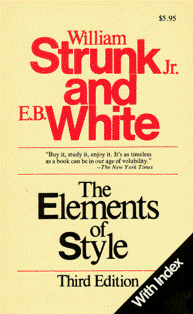I adore finding typos. A dark little corner of my heart absolutely fills with glee whenever I discover a misplaced apostrophe (just last week I spied an “it’s” where an “its” should be in a pamphlet my local school district published) or a misspelled word (most recently in a paperback copy of L. Frank Baum’s Rinkitink in Oz).
The crowning glory of my error-locating efforts, however, was reached the day I found an extra “n” in the word “sinner” in the LDS edition of the Holy Bible. (It’s been corrected in the most recent printing, but anyone who’s interested can email me and I’ll be glad to share the book, chapter and verse. As a bonus, I’ll point you to the two Bible Dictionary entries with typos as well!) This persistent giddiness really has nothing to do with a sense of superiority or schadenfreude; it just makes my type-A self so happy to find something to set right.
The authors of the books reviewed below, both the classic and its more modern cousin, share my joy in setting things as they should be. If you, dear reader, experience that same thrill, add these books to your list of necessary reading material immediately.
“Make every word tell.”
The Elements of Style
By William Strunk, Jr. and E. B. White
 This slim volume is densely packed with clear, concise tips and suggestions for writers, editors, and lovers of language. Within 85 pages, Mr. Strunk and Mr. White manage to include 175 wide-ranging and useful rules regarding grammar, punctuation, word usage and writing style. These guidelines are stated in such a matter-of-fact tone that the book, short as it is, gives of an aura of unquestioned authority. It could come across as intimidating, if not for the tongue-in-cheek self-awareness throughout. For example, one point in “Section V: An Approach to Style” reads as follows:
This slim volume is densely packed with clear, concise tips and suggestions for writers, editors, and lovers of language. Within 85 pages, Mr. Strunk and Mr. White manage to include 175 wide-ranging and useful rules regarding grammar, punctuation, word usage and writing style. These guidelines are stated in such a matter-of-fact tone that the book, short as it is, gives of an aura of unquestioned authority. It could come across as intimidating, if not for the tongue-in-cheek self-awareness throughout. For example, one point in “Section V: An Approach to Style” reads as follows:
- Avoid the use of qualifiers.
Rather, very, little, pretty—these are the leeches that infest the pond of prose, sucking the blood of words. The constant use of the adjective little (except to indicate size) is particularly debilitating; we should all try to do a little better, we should all be very watchful of this rule, for it is a rather important one and we are pretty sure to violate it now and then.
Mr. Strunk, an English professor at Cornell University, initially wrote and self-published his “little book” in 1918. Mr. White joined the process in 1959, thirteen years after Mr. Strunk’s death, when he was asked to revise and update his former teacher’s work. The copy I reread for this review was a third edition, first published in 1979. A fourth edition came out in 2000 with some updates to reflect current usage, including a preference—dismissively scorned in earlier editions—for using gender-inclusive language whenever possible. Another point that I’m afraid Messrs. Strunk and White failed to win is listed in the section titled “Misused Words and Expressions.”
-ize. Do not coin verbs by adding this tempting suffix. Many good and useful verbs do end in -ize: summarize, temporize, fraternize, harmonize, fertilize. But there is a growing list of abominations: containerize, customize, prioritize, finalize, to name four. Be suspicious of -ize.
While I’m not familiar with the term containerize, the other three “abominations” listed are definitely part of the common vernacular today. Sorry, guys!
The Elements of Style is perhaps best known for its intense focus on brevity and clarity, and its insistence that each word be precise and necessary.
Omit needless words.
Vigorous writing is concise. A sentence should contain no unnecessary words, a paragraph no unnecessary sentences, for the same reason that a drawing should have no unnecessary lines and a machine no unnecessary parts.
While the section organization seems somewhat arbitrary and several of the rules are truly matters of opinion rather than the exacting edicts they profess to be, Messrs. Strunk and White’s timeless classic is a must-have reference for every writer. Anyone who peruses The Elements of Style will close the book having gleaned at least a couple of techniques with which to improve his or her writing.
“Yes, some of us were born to be punctuation vigilantes.”
Eats, Shoots & Leaves: The Zero Tolerance Approach to Punctuation
By Lynne Truss


Gleefully anthropomorphizing these dots and squiggles, Ms. Truss paints an amusing portrait of punctuation’s home life. “In the family of punctuation,” she theorizes, “where the full stop [period] is daddy and the comma is mummy, and the semicolon quietly practises the piano with crossed hands, the exclamation mark is the big attention-deficit brother who gets over-excited and breaks things and laughs too loudly.” In Ms. Truss’s world, punctuation marks have feelings and deserve to be treated with the same consideration we would offer any other misused soul. She tentatively wonders if it “seems hurtful to suppress the exclamation mark when – after all – it doesn’t mean any harm to anyone, and is so desperately keen.” After enumerating the impressively long list of tasks which the humble apostrophe is called upon to complete, she implores her readers, “I hope that by now you are already feeling sorry for the apostrophe…frantically multi-tasking…dotting hither and yon, and succumbing to burnout from all the thankless effort.” Commas are “unstoppably enthusiastic,” semicolons are “upstanding,” and dashes are “handsome.” When Ms. Truss describes them so, it’s hard not to see punctuation as having personalities all their own.
Ms. Truss laments the damage that has been done to punctuation by, of all things, the Internet. Her particular target? Emoticons. They are, according to Ms. Truss, “a paltry substitute for expressing oneself properly” and “designed by people who evidently thought the punctuation marks on the standard keyboard cried out for an ornamental function.” In a nod to the revered guide reviewed above, and with only a mild whiff of wistfulness, she relates the satirical news story, published in The Washington Post in 1999, about a new computer virus named the “Strunkenwhite” which would not allow emails with grammatical errors to be sent. If only…
For all her hysterical grammatical fussiness, Ms. Truss does advocate a middle ground between staunchness and flexibility when it comes to punctuation. If the intent of punctuation is to provide “the greatest clarity,” she asserts that “in some matters of punctuation there are simple rights and wrongs; in others, one must apply a good ear to good sense.” This is, of course, complicated by the fact that each individual stickler has his or her own personal punctuational pet peeve – whereas one can not abide Oxford commas, another goes bonkers at inappropriate hyphenation. Nevertheless, she urges “Sticklers unite, you have nothing to lose but your sense of proportion, and arguably you didn’t have a lot of that to begin with.
”
Eats, Shoots & Leaves was written for a single purpose.
Ms. Truss explains, “Well, you know those self-help books that give you permission to love yourself? This one gives you permission to love punctuation.” It is truly wonderful to know that I’m not alone!
**************************
On My Bedside Table…
Just finished: Moneyball: The Art of Winning an Unfair Game by Michael Lewis
Now reading: A Stolen Life: A Memoir by Jaycee Dugard
On deck: What Our Mothers Didn’t Tell Us by Danielle Crittenden
**************************
One more column on reading and writing coming up in two weeks! Come find me on goodreads.com or email suggestions, comments, and feedback to egeddesbooks (at) gmail (dot) com.

















